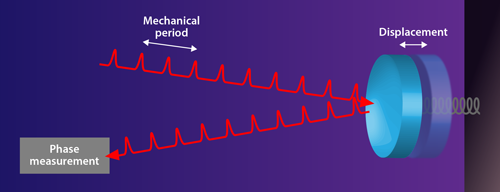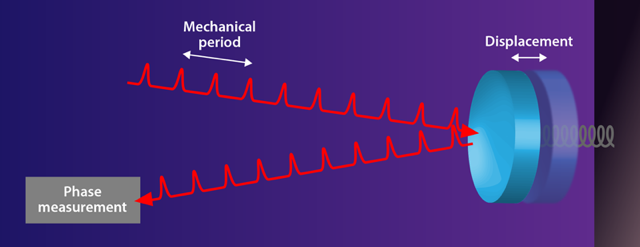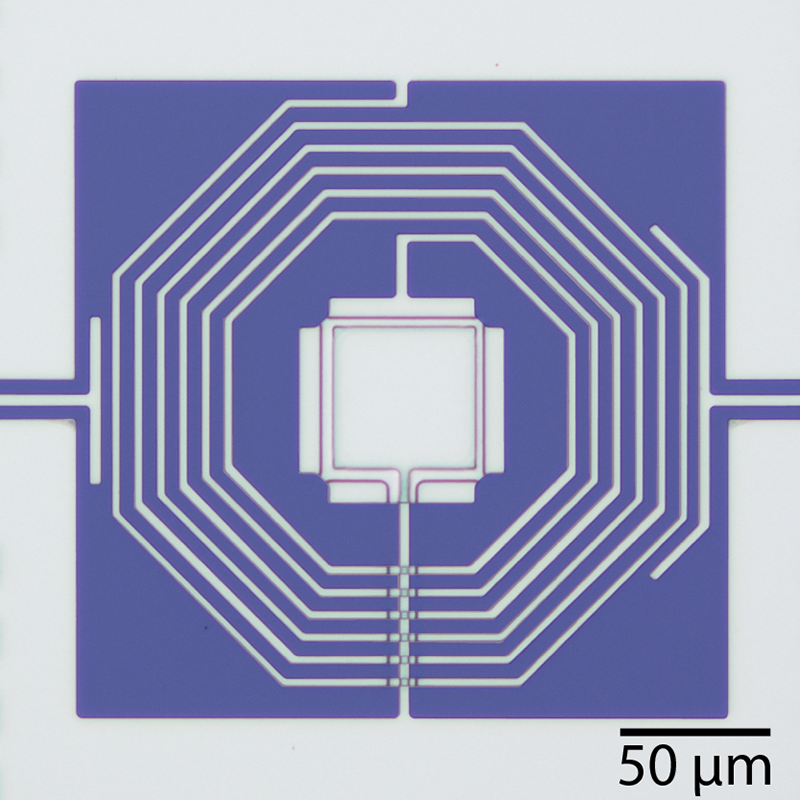Quantum Squeezing of Micromechanical Motion
Since the birth of quantum mechanics, it has been known that the very act of measuring a quantum system perturbs its behavior. This measurement backaction is a general feature of quantum mechanics and can often be deleterious. For instance, in measurements of position, it results in a so-called standard quantum limit to the precision—counterintuitively, measuring the system too strongly actually decreases the measurement precision. But it has been recognized for some time that measurement backaction can also be used to control quantum systems (see, for example, Ref. [1]). In three recent studies [2–4] by independent groups, such an approach has been used to overcome the standard quantum limit. The researchers have reduced the uncertainty in the motion of a micromechanical oscillator beneath the quantum uncertainty, or zero-point motion, that exists even if an oscillator is cooled into its lowest-energy motional state at absolute zero. These results open the door for studies of quantum mechanics at length and mass scales where physics has previously been well described by classical theories, and for applications such as quantum sensors of forces, fields, and acceleration [5].
The field of quantum optomechanics uses electromagnetic fields such as light and microwaves to measure and control the motion of mechanical objects—most particularly mechanical oscillators such as vibrating membranes—at a quantum level [5]. The importance of quantum mechanics in this context was first fully recognized in efforts to design large ground-based interferometers to detect gravitational waves. In such apparatuses, light is used to measure differential changes in the position of the end-mirrors of the interferometer. The light exerts forces on the end-mirrors via radiation pressure and introduces uncertainty in their motion due to the random arrival times (or “shot noise”) of individual photons. This sets the standard quantum limit to the detector’s sensitivity and can mask the signal from gravitational waves. This motivated research into methods to surpass the standard quantum limit (see, for example, Refs. [1, 6–8]), most commonly using a so-termed backaction evading, or quantum nondemolition, measurement.
The simplest form of a backaction evading measurement, proposed more than three decades ago [1], is a stroboscopic measurement of the position of a mechanical oscillator (Fig. 1). This involves reflecting a sequence of light pulses from the mechanical oscillator, separated in time by half a period of the oscillator’s motion. The phase of each reflected pulse contains information about the position of the oscillator, while the quantum uncertainty in the number of photons (shot noise) in the pulse introduces uncertainty in the momentum of the oscillator via radiation pressure. This momentum uncertainty would usually contaminate future position measurements. But by spacing the pulses by half the oscillation period, simple harmonic oscillation dictates that any uncertainty introduced by one pulse is converted, first to position uncertainty, and then back to momentum uncertainty at the arrival time of the next pulse. Thereby, each pulse experiences none of the backaction introduced by prior pulses. This enables a measurement that is, at least in principle, immune to quantum backaction and can resolve, or squeeze, the position of the oscillator with a precision exceeding even its quantum zero-point motion.
While the theory of quantum optomechanics has been well developed for several decades, only in the past few years has it become possible to explore many of its predictions experimentally. This is thanks to advances in both fabrication of high-quality micromechanical oscillators and improved capabilities to confine electromagnetic fields at the microscale and therefore increase the strength of the light-oscillator interaction. Quantum backaction due to the radiation pressure shot noise of light was first observed on a micromechanical oscillator in 2013 [9]. In the same year, entanglement induced by quantum backaction was observed between a micromechanical oscillator and a microwave field, using a superconducting microwave circuit [10] similar to those utilized in the new experiments of Refs. [2–4].
These experiments, by groups led by Keith Schwab [2] at the California Institute of Technology, Pasadena, by Mika Sillanpää [3] at the Aalto University School of Science, Finland, and by John Teufel [4] at the National Institute of Standards and Technology, Colorado, follow very similar approaches and go beyond those demonstrations. The researchers show, for the first time, that a micromechanical oscillator can be squeezed beyond its quantum zero-point motion. Each experiment was performed using a superconducting optomechanical device, consisting of an LC (inductor-capacitor) electrical circuit and a suspended membrane forming one of the plates of the capacitor (Fig. 2). Mechanical drum-like vibrations of this membrane are coupled to the resonance frequency of the circuit via the change they induce to the capacitance. The three teams used a variant of the basic backaction evading measurement, referred to as two-tone driving [10], to produce mechanical squeezing. Here, two monochromatic electromagnetic fields that are separated in frequency by twice the mechanical resonance frequency are injected into the circuit. In the time domain, the beat caused by interference between the two fields produces a sinusoidally modulated intensity with a period identical to the pulse sequence used in a conceptually simple stroboscopic experiment.
The lower-frequency field can be viewed as a cooling field, extracting energy from the oscillator, while the higher-frequency field instead heats the oscillator. If the intensities of the fields are perfectly balanced, these two effects cancel, allowing a perfect backaction evading measurement [8]. The present studies, rather than working at this exact operating point, biased the lower-frequency field to a higher intensity, introducing a net cooling effect. This allowed, in each experiment, squeezing of the mechanical motion to a level approximately 20% beneath the level of the quantum zero-point motion.
These experiments have important ramifications both for fundamental studies of quantum physics and for precision sensing of weak signals such as forces and fields. With quantum mechanics more than a century old, our understanding of the transition between quantum behavior at atomic scales and the classical behavior of everyday systems still remains incomplete. These studies advance our ability to study the quantum–classical transition by allowing the observation of quantum behavior at length scales visible to the naked eye and in systems consisting of atoms. Micromechanical oscillators are widely used in applications ranging from timing and synchronization to high-precision sensing of force, field, mass, and acceleration. By providing a pathway to improve the noise performance of such applications, the technique demonstrated by the three teams to control the quantum uncertainty of such oscillators may have significant future impact.
This research is published in Physical Review Letters, Physical Review X and Science.
References
- V. B. Braginsky, Y. I. Vorontsov, and K. S. Thorne, “Quantum Nondemolition Measurements,” Science 209, 547 (1980).
- E. E. Wollman, C. U. Lei, A. J. Weinstein, J. Suh, A. Kronwald, F. Marquardt, A. A. Clerk, and K. C. Schwab, “Quantum Squeezing of Motion in a Mechanical Resonator,” Science 349, 952 (2015).
- J.-M. Pirkkalainen, E. Damskägg, M. Brandt, F. Massel, and M. A. Sillanpää, “Squeezing of Quantum Noise of Motion in a Micromechanical Resonator,” Phys. Rev. Lett. 115, 243601 (2015).
- F. Lecocq, J. B. Clark, R. W. Simmonds, J. Aumentado, and J. D. Teufel, “Quantum Nondemolition Measurement of a Nonclassical State of a Massive Object,” Phys. Rev. X 5, 041037 (2015).
- W. P. Bowen and G. J. Milburn, Quantum Optomechanics (Quantum Optomechanics, Boca Raton, 2015)[Amazon][WorldCat].
- H. J. Kimble, Y. Levin, A. B. Matsko, K. S. Thorne, and S. P. Vyatchanin, “Conversion of Conventional Gravitational-Wave Interferometers into Quantum Nondemolition Interferometers by Modifying their Input and/or Output Optics,” Phys. Rev. D 65, 022002 (2001).
- A. Szorkovszky, A. C. Doherty, G. I. Harris, and W. P. Bowen, “Mechanical Squeezing via Parametric Amplification and Weak Measurement,” Phys. Rev. Lett. 107, 213603 (2011).
- A A Clerk, F Marquardt, and K Jacobs, “Back-action Evasion and Squeezing of a Mechanical Resonator Using a Cavity Detector,” New J. Phys. 10, 095010 (2008).
- T. P. Purdy, R. W. Peterson, and C. A. Regal, “Observation of Radiation Pressure Shot Noise on a Macroscopic Object,” Science 339, 801 (2013).
- T. A. Palomaki, J. D. Teufel, R. W. Simmonds, and K. W. Lehnert, “Entangling Mechanical Motion with Microwave Fields,” Science 342, 710 (2013).







